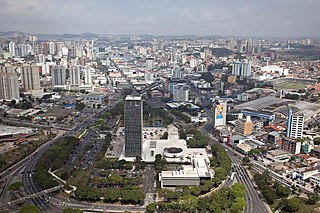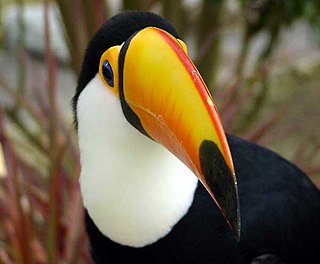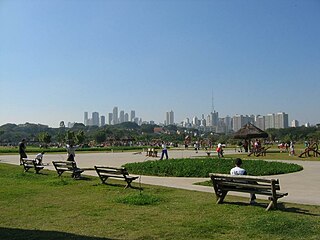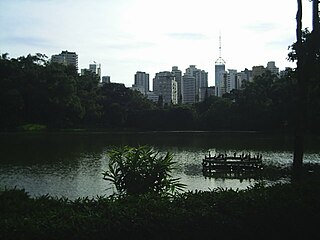
São Paulo is one of the 26 states of the Federative Republic of Brazil and is named after Saint Paul of Tarsus. It is located in the Southeast Region and is limited by the states of Minas Gerais to the north and northeast, Paraná to the south, Rio de Janeiro to the east and Mato Grosso do Sul to the west, in addition to the Atlantic Ocean to the southeast. It is divided into 645 municipalities and its total area is 248,219.481 square kilometres km2, which is equivalent to 2.9% of Brazil's surface, being slightly larger than the United Kingdom. Its capital is the municipality of São Paulo.

The Atlantic Forest is a South American forest that extends along the Atlantic coast of Brazil from Rio Grande do Norte state in the northeast to Rio Grande do Sul state in the south and inland as far as Paraguay and the Misiones Province of Argentina, where the region is known as Selva Misionera.

Chusquea is a genus of evergreen bamboos in the grass family. Most of them are native to mountain habitats in Latin America, from Mexico to southern Chile and Argentina.

Bandeirantes were settlers in Portuguese Brazil who participated in exploratory voyages during the early modern period to expand the colony's borders and subjugate indigenous Brazilians. They played a major role in expanding the colony to the modern-day borders of independent Brazil, beyond the boundaries demarcated by the 1494 Treaty of Tordesillas. Bandeirantes also enslaved thousands of indigenous people, which ultimately played a major role in the genocide of Indigenous peoples in Brazil.

São Bernardo do Campo is a Brazilian municipality in the state of São Paulo.

The Cerrado is a vast ecoregion of tropical savanna in eastern Brazil, being present in the states of Goiás, Mato Grosso do Sul, Mato Grosso, Tocantins, Maranhão, Piauí, Bahia, Minas Gerais, São Paulo, Paraná and the Federal District. The core areas of the Cerrado biome are the Brazilian highlands – the Planalto. The main habitat types of the Cerrado consist of forest savanna, wooded savanna, park savanna and gramineous-woody savanna. The Cerrado also includes savanna wetlands and gallery forests.

The black-faced lion tamarin or Superagüi lion tamarin is a small New World monkey of the family Callitrichidae. It is endangered and endemic to coastal forests in southeastern Brazil. There are several conservation projects and the total populations is unlikely to exceed 400 individuals. It is overall golden-orange with contrasting black head, legs and tail.

Mendoncia puberula is a species of flowering plant in the family Acanthaceae. It is a liana native to tropical South America, ranging from Venezuela, Colombia, and Ecuador through northern, central, and southern Brazil.

Mendoncia velloziana is a species of flowering plant in the family Acanthaceae. It is a liana native to tropical South America, ranging from Colombia and Peru through northern, eastern, and southern Brazil to Paraguay.

Mendoncia is a genus of climbing plants in the family Acanthaceae.

The wildlife of Brazil comprises all naturally occurring animals, plants, and fungi in the South American country. Home to 60% of the Amazon Rainforest, which accounts for approximately one-tenth of all species in the world, Brazil is considered to have the greatest biodiversity of any country on the planet. It has the most known species of plants (60,000), freshwater fish (3,000), amphibians (1,188), snakes (430), insects (90,000) and mammals (775) It also ranks third on the list of countries with the most bird species (1,971) and the third with the most reptile species (848). The number of fungal species is unknown. Approximately two-thirds of all species worldwide are found in tropical areas, often coinciding with developing countries such as Brazil. Brazil is second only to Indonesia as the country with the most endemic species.

Ocotea porosa, commonly called imbuia or Brazilian walnut, is a species of plant in the Lauraceae family. Its wood is very hard, and it is a major commercial timber species in Brazil.

Even though progress has been made in conserving Brazil’s landscapes, the country still faces serious threats due to its historical land use. Amazonian forests substantially influence regional and global climates and deforesting this region is both a regional and global driver of climate change due to the high amounts of deforestation and habitat fragmentation that have occurred this region.
Spanish emigration peaked in the late 19th and early 20th centuries, and it was concentrated to Argentina, Uruguay and Cuba. Between 1882 and 1930, 3,297,312 Spaniards emigrated, of whom 1,594,622 went to Argentina and 1,118,960 went to Cuba. Brazil only started to be an important destination for immigrants from Spain in the 1880s, but the country received the third largest number of Spanish emigrants, behind only the two aforementioned countries. Spaniards also made up the third largest national group to immigrate to Brazil, after the Italians and Portuguese.

Syagrus cearensis is a natural palm endemic to Brazil.

The Xitué Ecological Station is an ecological station in the state of São Paulo, Brazil. It protects a mountainous area of Atlantic Forest.

The Albert Löfgren State Park, commonly known as the São Paulo Forest Gardens is a state park in the state of São Paulo, Brazil.

Villa-Lobos State Park is a park in São Paulo, Brazil. It is named after composer Heitor Villa-Lobos, and is located next to Pinheiros River. It was created in 1989 on a site that was previously used as a rubbish tip. The park now has around 37,000 trees. It hosts the annual Aberto de São Paulo.

Butia archeri is a small species of Butia palm with a short trunk native to the states of Goiás, Brasília, Minas Gerais and São Paulo in Brazil.

Aclimação Park is a public leisure area located in the Aclimação district, in the central area of the Brazilian city of São Paulo. It opened on September 16, 1939, and covers an area of 112,000 square meters. It dates back to 1892, when Carlos Botelho decided to establish a garden on the site inspired by the Jardin d'Acclimatation in Paris. It was acquired by São Paulo City Hall in the 1930s.


















